Intro
For this critical play, I played Gorogoa developed by Jason Roberts and published by Annapurna Interactive. Gorogoa is available on multiple platforms, including the Microsoft Windows, Nintendo Switch, iOS, etc. I choose to play Gorogoa on the iOS system. From my own playing experience, I say the Gorogoa is suitable for players enjoying fragmented, mobile and elusive narrative and simple gameplay. It is also suitable for players enjoying a more free gameplay experience without much aid or guidance – the fun of figuring out things by themselves.

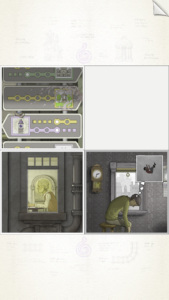
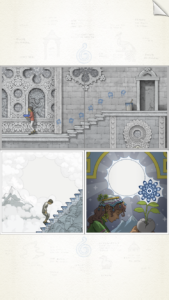
Mechanics
Gorogoa is a simple puzzle game, and the gameplay is both intuitive and innovative. It is intuitive since it very much resembles a traditional puzzle, and the possible moves that a player can take are placing or stacking tiles. What is innovative about this puzzle is that, compared to traditional puzzles having the goal of completing the picture in space, Gorogoa is completing a spatiotemporal story through moving the pieces. As the tiles in the grids are pieced together forming a decipherable image, the chapter progresses and the storyline becomes more decipherable: the boy, facing a strange monster, is gathering different kinds of elements.
It is interesting to see how Gorogoa makes the puzzle spatiotemporal: how to show the progression of the narrative? how to demonstrate a three-dimensional imaginative space? One of the interesting mechanics Gorogoa employed is that sometimes a tile is a mask for another tile, and through masking the image becomes “alive”. Objects and characters can move between different spaces depicted in different tiles, making the scenes scattered while interconnected with each other at the same time. There is an elegance and weirdness in the motion, especially when two drastically different spaces become one, which fits the overall elusive style of the narrative.
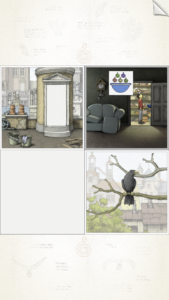
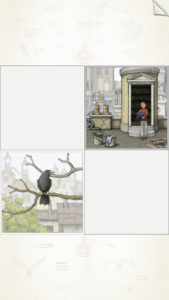
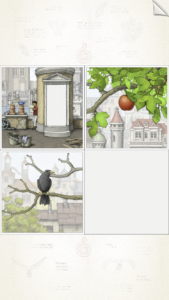
Interesting Takeaway
I feel one interesting takeaway from this game is the way it deals with the lack of textual aid. Since our group’s game will be an audio game with minimum to none textual aid, and text is usually the main source of information for players when they are trying to navigate through a game, knowing how to convey the objectives and rules to the players without text is very important. Some of the successful practices of the games are:
- Hints for where to click. There are bright circles circling out places that the player could choose to click, which really helps with the gameplay since there are no rulebooks to refer to.
- Simple storyline and minimum information for remembering and recalling. The narrative is pretty simple and there is no crucial information that needs to be remembered in order to proceed with the game.
- Repeated patterns. After a few rounds, I feel that I’m gradually “getting it”, since I start to see the patterns for solving the puzzles. With the newly learned pattern, I don’t really need much guidance on what the goal is, or what the possible tricks are.
- From simple to difficult. The first several chapters involve less complicated puzzles and puzzle combinations, which is suitable for the player’s learning curve.




